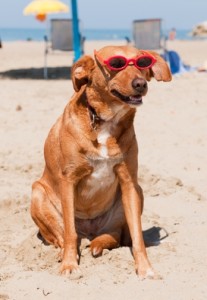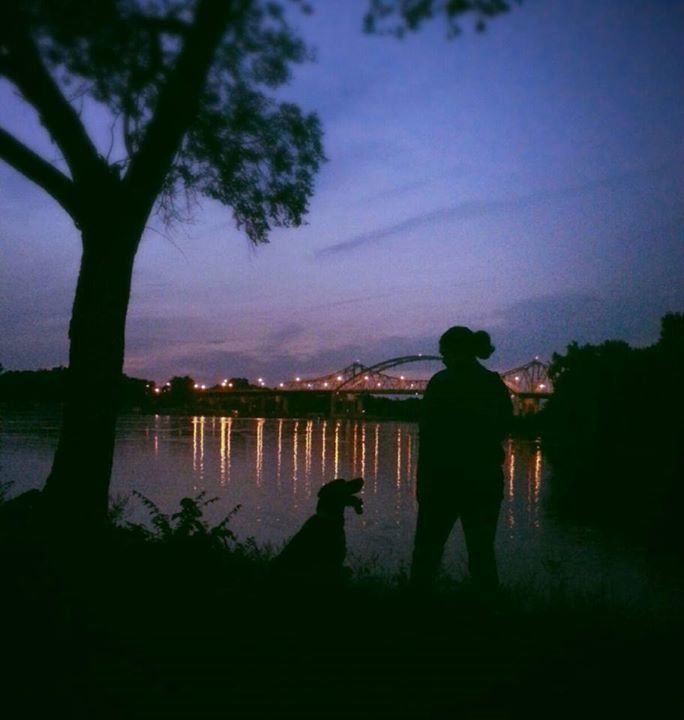
We want to wish you all a happy Fourth of July!
Many of you will be spending time outdoors this week with friends and family
and of course, your dogs. There will be lots of grilling, outdoor sports,
parades and fireworks. While we hope you all have tons of fun, we also
want to mention some important safety tips for our dogs.
Tips for keeping dogs safe in the heat and during fireworks
Safe ways to exercise
Since I have an older, black dog, I need to be mindful of when I exercise him so he doesn’t get overheated. This is something all dog owners should be thinking about, especially in the summer. For example, I try to walk my dog early in the morning or in the evening when it’s not as hot.
If you need to provide exercise to your dog in the middle of the day, you could consider taking him for a walk through an air-conditioned, pet friendly store. Indoor games like “find it” or tug of war are other options.
If you do have to walk your dog in the heat, be aware of potentially hot pavement, hot sand or other hot surfaces.
“It is a good idea to test the surface with bare feet or with the palm of your hand,” said Dr. Debra Nickelson, the resident veterinarian at the pet-care company, Lambert Kay. “If it is too uncomfortable for you, it is probably too uncomfortable for your dog.”
She said if your dog starts tiptoeing, lifting his feet or looking as though he is walking over glass, you should remove him from the surface immediately.
Know the signs of heat exhaustion in dogs
“Heat exhaustion in dogs is caused by over activity and insufficient cooling,” according to Nickelson.
She said if heat exhaustion worsens it can lead to heat stroke, which is a central nervous system disturbance that can lead to organ failure. Heat stroke is more common in breeds with short muzzles such as boxers and pugs.
One area where pet owners need to be cautious of heat exhaustion or heat stroke is in the car, she said. According to a study by the American Veterinary Medical Association, the interior temperatures of vehicles ranging from 72 to 96 degrees Fahrenheit rose steadily as time increased.
"This can quickly create a dangerous environment for any dog, and cracking the window does not help," she said.
Nickelson listed some of the signs of heat stroke such as:
- excessive panting
- drooling
- “saliva foam”
- bright red gums
- labored breathing
- lethargic behavior
- trouble walking or balancing
- seizures
- blood in the vomit, urine or stool
If you think your dog may be suffering from heat exhaustion or heat stroke, Nickelson warned that the dog must be cooled gradually.
“Pet parents can do so with cool, wet towels,” she said.
Her other suggestions included gently pouring cold water over exposed areas like the stomach or to encourage the dog to rest on a cool, hard floor surface next to a fan.
She also said to call your dog’s veterinarian immediately.

Safety tips during fireworks
Nikki Thompson is the director of education and outreach for the Bucks County (Pennsylvania) SPCA. She said the shelter regularly takes in many animals on July 5 due to dogs getting scared from the fireworks and running off the day before.
I asked if she had any tips on how to keep dogs safe during fireworks or thunderstorms.
She said it’s best to put your dog in a room where you can draw the blinds or curtains. Ideally this room should not have an exterior door because many pets get scared by the noise and run to the nearest exit.
Thompson also said to put on a soft light for the pet and to have a radio or TV on in the room just a little louder than you normally would. It also helps to provide the pet with a “safe” place to hide such as under a blanket, in a kennel or under a bed.
“My miniature pinscher/Chihuahua mix, Gwen, shakes so bad that her muscles ache the next day,” Thompson said. “So hiding under lots of blankets helps her to reduce that stress.”
She also said to make sure your pet is wearing a secure collar with readable ID tags.
“If they do get out, they are much more likely to return home quickly if they can be identified.”
How about the rest of you? What tips do you have for keeping dogs safe over the Fourth of July?

